1640
In need of funds, Charles summons parliament but his demands are denied. Parliament is dismissed in a matter of weeks.
In need of funds, Charles summons parliament but his demands are denied. Parliament is dismissed in a matter of weeks.
After the Scottish Covenanters capture Newcastle and Durham, Charles I summons another parliament.
Parliament begins impeachment proceedings against Charles' key counsellors, leading to their exile or execution.
Charles I assents to a series of Acts of Parliament which limit his power to dismiss parliament and rule independently.
Rebellion breaks out in Ireland.
The House of Commons issues the Grand Remonstrance, a list of grievances against Charles' reign.
Charles I enters the House of Commons in a failed attempt to arrest five members accused of high treason.
A confederate government is established in Ireland.
Charles I and his family leave London, which is under control of Parliament.
Charles I and Parliament each begin to raise armies.
Charles I raises the royal standard at Nottingham.
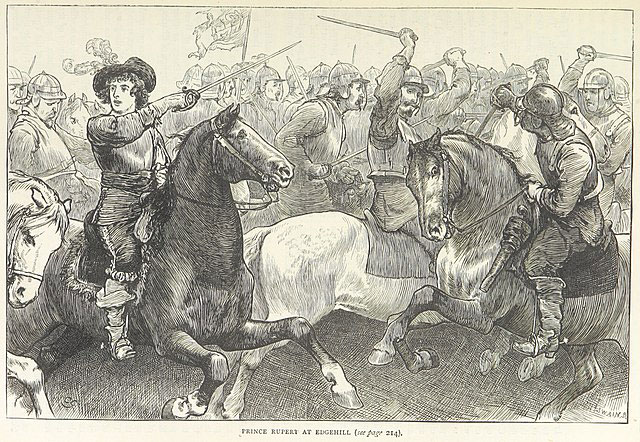
Parliamentarian and Royalist armies clash in the battle of Edgehill.
A Royalist advance on London is repelled at Turnham Green.
Royalist forces find success at Adwalton Moor and Bristol.
Parliamentarian and Royalist armies clash in the battle of Newbury.
Scottish forces invade England in support of Parliament.
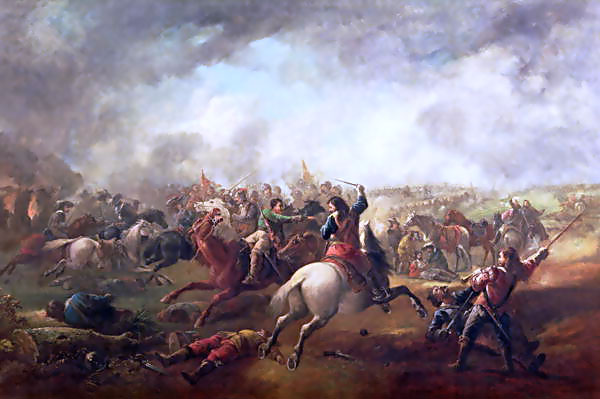
Charles I's nephew, Prince Rupert of the Rhine, is defeated by a joint Parliamentary and Scottish force at Marston Moor, breaking Royalist power in the north.
The Earl of Essex is defeated at Lostwithiel, the last major Royalist victory of the war.
The Self-denying Ordinance reforms the Parliamentarian military leadership.
The Parliamentarian New Model Army is created.
Parliamentarian forces win decisive victories at the battles of Naseby and Langport.
As it becomes clear that the Royalist cause is lost, Charles I surrenders himself to Scottish forces at Newark.
Charles I is delivered to parliamentary commissioners and placed under house arrest.
The New Model Army holds debates on the future form of government.
Charles I negotiates in secret for Scottish support.
A series of Royalist uprisings, and an invasion of northern England by Scottish forces, are defeated.
Colonel Thomas Pride stations soldiers outside Parliament, blocking entry to opponents of the army.
Charles I is placed on trial, convicted of treason, and executed.
Parliament declares England a Commonwealth.
Oliver Cromwell invades Ireland, committing massacres at Drogheda and Wexford.
Charles II, previously exiled in the Hague, lands in Scotland and is crowned at Scone.
The first British coffee house opens in Oxford.
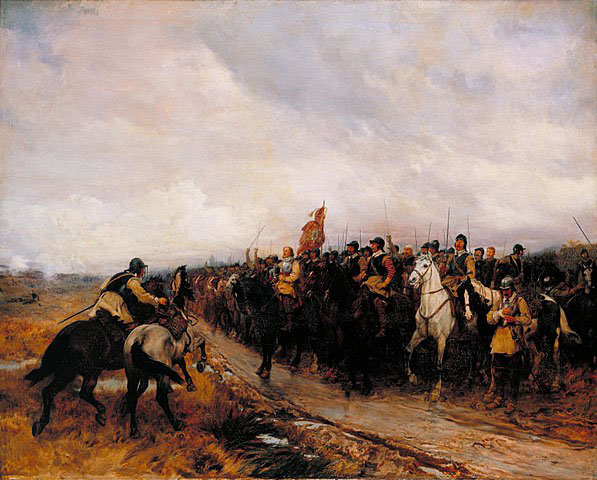
Oliver Cromwell launches an invasion of Scotland to forestall Scottish support for Charles II, and achieves a victory at Dunbar.
Charles II is defeated at Worcester and forced to return to exile.
First Anglo-Dutch War.
Cromwell dismisses the Rump Parliament and installs himself as Lord Protector.
Anglo-Spanish War.
Cromwell dissolves the Protectorate Parliament in favour of direct military rule.
Cromwell initiates the readmission of Jews to Britain.
Britain's first Chocolate House is advertised in Bishopsgate Street, London.
Oliver Cromwell dies and is succeeded as Lord Protector by his son, Richard.
Richard Cromwell is deposed by the army and the Rump Parliament is reinstated, ending the protectorate.
Competition between the Rump Parliament and the military leadership causes a political crisis in England.
George Monck, the commander of English forces in Scotland, marches south and reinstates the Long Parliament.
The Long Parliament dissolves itself and calls for the election of a new assembly, the Convention Parliament.
Charles II issues the Declaration of Breda, promising a general pardon for crimes committed during the Civil War and Interregnum for those who recognised him as the lawful king.
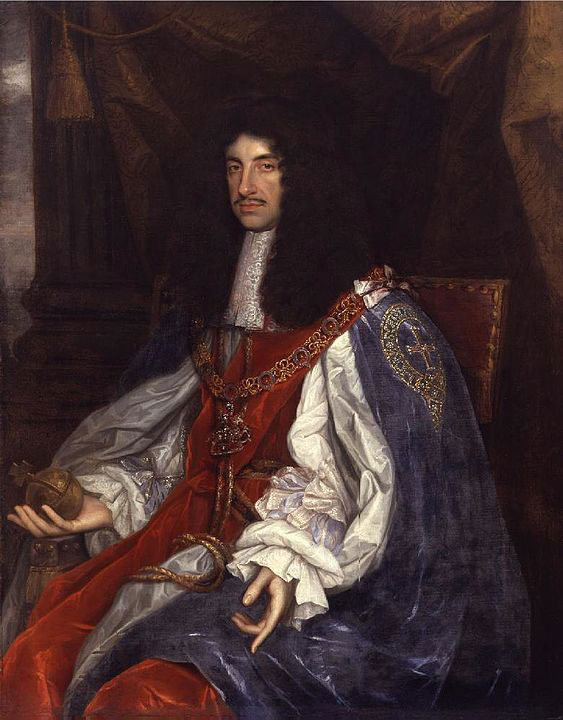
The Convention Parliament restores Charles II to the throne.
The Royal Society is founded.
Samuel Pepys keeps a diary.
The Corporation Act requires all municipal officials to take the Anglican communion.
The Act of Uniformity makes the Book of Common Prayer compulsory in religious services.
Charles II marries Catharine of Braganza, securing Tangier and Bombay for England as part of her dowry.
Parliament institutes the hearth tax to support the royal household.
The Settlement Act gives each person a place of 'settlement', clarifying which parish is responsible for their relief.
The Conventicle Act forbids nonconformist worship for groups of five or more.
The Five Mile Act forbids nonconformist ministers from coming closer than five miles to towns where they have ministered.
Plague strikes London.
Second Anglo-Dutch War.
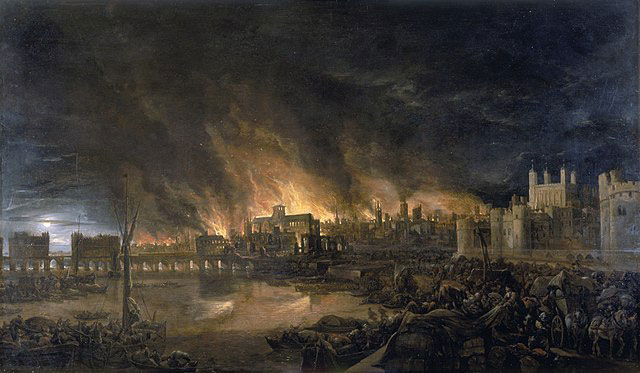
The Great Fire of London causes the destruction of around 13,000 homes and many public buildings. A special fire court is established to help destitute tenants rebuild their homes.
Paradise Lost is published.
A Dutch fleet sails up the Thames and launches a devastating raid on the English navy.
The Treaty of Breda. Britain cedes its interests in Sumatra and the Spice Islands to the Netherlands in return for New Amsterdam.
The English East India Company establishes a trading base in Bombay.
England, Sweden and the Netherlands form an alliance to oppose France in the War of Devolution.
Charles II's brother and heir to the throne, the future James II, converts to Catholicism.
In the Treaty of Dover, Charles II promises to support French policy in Europe and convert to Catholicism in exchange for a yearly pension, though he never converts.
Third Anglo-Dutch War.
Charles II issues a Declaration of Indulgence, suspending the penal laws against Catholics and other religious nonconformists.
Parliament passes the Test Act, excluding Catholics and nonconformists from public office.
Work begins on the new St Paul's Cathedral.
Charles II's niece, Mary, marries William of Orange.
The Monument, a commemoration of the Great Fire of London, is completed.
A fictitious conspiracy, the Popish Plot, leads to anti-Catholic hysteria in England and Scotland.
The Pilgrim's Progress, by John Bunyan, is published.
Members of Parliament introduce the Exclusion Bill in an attempt to exclude the Duke of York, the future James II, from the line of succession.
Louis XIV of France renews persecution of Huguenots, causing many to flee to England.
Edmond Halley charts and describes the orbit of a comet which is named after him.
The Rye House Plot, a conspiracy to assassinate Charles II and the Duke of York, is uncovered.
The Thames freezes over and fairs are held on the ice.

On the death of Charles II, his brother James II accedes to the throne.
Charles II's illegitimate son, the Duke of Monmouth, leads an unsuccessful rebellion against James II.
Isaac Newton publishes Principia Mathematica, in which he formulates his laws on gravity.
James II issues a Declaration of Indulgence, suspending penal laws against Catholics and other religious nonconformists.
A son is born to James II, ushering in the prospect of a permanent Catholic dynasty in Britain.
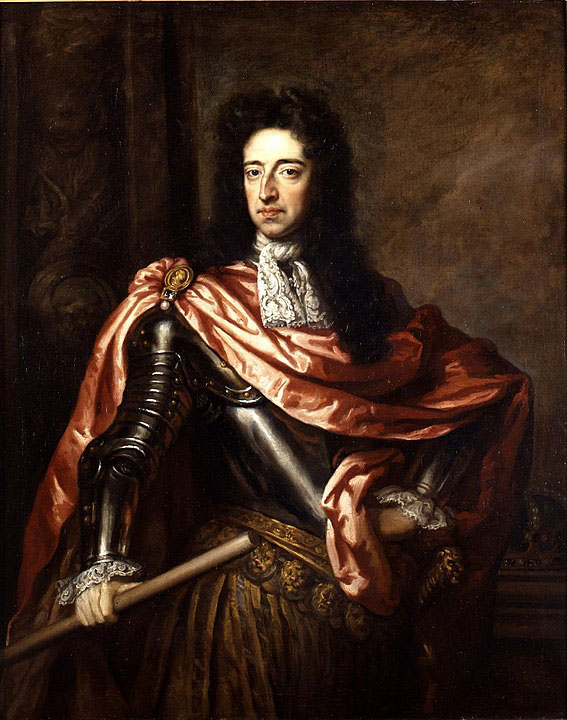
Leading Protestant noblemen invite William of Orange to invade England.
When William of Orange lands in England, James II flees the country.
Conflict between supporters of James II and William of Orange in Ireland.

Parliament installs William III and Mary II as joint rulers.
War between supporters of James II and William III in Scotland.
England enters the Grand Alliance against France, leading to nine years of war on the continent.
William III wins a decisive victory over James II at the Battle of the Boyne.
James II's French and Irish supporters are defeated at Aughrim, leading to a collapse of Jacobite support in Ireland.
The Bank of England is formed to raise funds for the war against France.
On the death of Mary II, William III becomes sole monarch.
The Treaty of Rijswijk marks the end of the Nine Years War.
The steam engine is invented by Thomas Savery.
Scotland makes a disastrous attempt to establish a colony at Darien in Panama.
James II dies in exile.
The Act of Settlement disqualifies Roman Catholics from inheriting the throne.
War of the Spanish Succession.
On the death of William III, Queen Anne accedes to the throne.
Queen Anne's War. Britain and France fight in Canada, New England, the Carolinas and Florida for control of the Americas.
The Act of Union merges the kingdoms of England and Scotland.